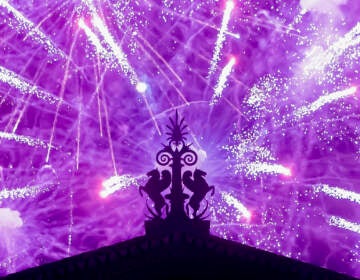‘Letting Off Steam’ with Princeton architect Michael Graves
When world-renowned architect Michael Graves was growing up in Indianapolis, he would draw all the time. To spare him the life of a starving artist, his mother suggested he pursue a career in either engineering or architecture. First, she told him what an engineer does.
This is part of a series from Ilene Dube of The Artful Blogger.
When world-renowned architect Michael Graves was growing up in Indianapolis, he would draw all the time. To spare him the life of a starving artist, his mother suggested he pursue a career in either engineering or architecture. First, she told him what an engineer does.
“I’ll be an architect,” he recounts telling her. “I didn’t know what an architect does, but I knew I didn’t want to be an engineer,” says the Princeton University Robert Schirmer Professor of Architecture Emeritus.
Although he still paints prolifically, Princeton-based Graves is not only a successful architect with 350 buildings worldwide, but Michael Graves Design Group has planned more than 2,000 products, from lighting, hardware and bath projects to, yes, the teakettle.
It is his iconic teakettle with the whistling bird that is the centerpiece of Michael Graves: Letting off Steam, on view at the Anne Reid ’72 Art Gallery at Princeton Day School through April 25.
How did the winner of the 1999 National Medal of Arts from President Clinton and the 2001 American Institute of Architects Gold Medal — the highest award bestowed on an architect — wind up designing household products?
In the 1980s, the Alessi kitchen utensil company in the Italian alps held a design competition for architects to design silver tea sets. “It didn’t matter if it didn’t work and cost wasn’t the issue,” Graves told Business Week in 2005. Graves won the competition. “It was a promotional project, not a commercial enterprise, and was going to be showcased in museums. And the Coffee and Tea Piazza, as mine was called, received a great response. It was wonderful to walk into the Whitney Museum and see all these objects on the first floor.”
On view here, the 1983 Tea and Coffee Piazza looks like Metropolis-style buildings made of fluted cylinders in a boxy shape with Bakelite knobs. In its first year, 25 units of the limited edition service sold for $25,000 each.
But function was important, so Alberto Alessi commissioned Graves to design the teakettle, its a red rooster whistle, a nod to his Indiana roots, a blue handle to keep fingers from burning, and a shape that would boil the water in a reasonable amount of time and not be too heavy to lift.
“Smiles don’t come easy to Alberto, but he smiled when he saw it,” Graves says in a short video in the exhibit. Today, 50,000 teakettles are produced each year. “When you see thousands of kettles, it does make you smile.”
The teakettle came out of the hardware story and into the galleries, and Michael Graves became a household name. Its fusion of art deco, Pop art and cartoon neoclassicism paved the way for the style of the 1990s.
Graves wanted good design to be available to everyone, but the $125 price tag was an obstacle. When Target began producing it for the mass market, he could realize his dream. More than 1,800 consumer products were brought to market.
The exhibit includes some of his preliminary sketches in which the teakettles, with their conical shapes and short shadows, look like Saul Steinberg buildings, or like the cedars in the Tuscan landscapes Graves paints. His personality is more apparent in his freehand line than in the geometry of measured blueprints. One latex painting on paper has an arrow pointing to the handle and the words “yucky teapot green.”
In addition to Alessi and Target, Graves made kettles for Disney, with handles that suggest mouse ears and a black silhouette of Mickey instead of the red bird.
A sketchbook in a case, with his neatly articulated curves, shadings and details, is proof that Graves is first and foremost an artist. On one wall, a diptych of colored pencil paintings is a patchwork of bright and whimsical patterns, including some with the mouse and his ears.
Not only did Graves design the objects in Letting Off Steam, his firm designed the exhibit, as well. “Michael’s firm spent 10 months putting this exhibition together,” says curator Jody Erdman. “They do not do anything half way. They worked with gallery floor plans for months to lay out the exhibit.”
As I wander the gallery, the sound of the whistling kettle from the video elicits a Pavlovian response: I want to run and turn off the stove.
The Artful Blogger is written by Ilene Dube and offers a look inside the art world of the greater Princeton area. Ilene Dube is an award-winning arts writer and editor, as well as an artist, curator and activist for the arts.
WHYY is your source for fact-based, in-depth journalism and information. As a nonprofit organization, we rely on financial support from readers like you. Please give today.




